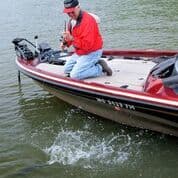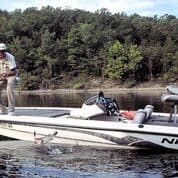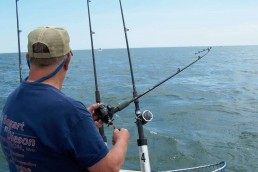Insider Secrets to Summer Bassin’ in Ozarks Lakes
SHARE THIS POST
Summer bass fishing is just around the corner, but it’s also peak watersports season on streams and reservoirs. Since competition for fishing space is unavoidable, well-informed anglers will have inside information on where to fish and what lures to use.
MidWest Outdoors readers are fortunate because Missouri’s Truman and Table Rock lakes and Lake of the Ozarks are within an easy drive, boast a plethora of species and offer a variety of accommodations.
Here are some tips for fishing those lakes:
Lake of the Ozarks
Meandering through the Ozark hills, Missouri’s oldest reservoir produces bass year after year in spite of the 700-plus annual tournaments. This year, anglers caught two bass with verified weights over 10 pounds, and one now swims in the Bass Pro Shops’ aquarium.
There is no standing timber, but the lake’s numerous docks and owner-submerged brush provide cover for bass and their forage.
Water temperatures are in the 70s now, but by the end of this month they can reach 80 degrees at the 20- or 25-foot depths, causing bass to hold in the brush. Some great lures for fishing deep brush are Texas-rigged Berkley Power Worms, Zoom’s Brush Hog or Crock-O-Gator jigs.
Anglers seem to prefer watermelon red-flake, grape, tequila sunrise, and blue or black as colors for their soft plastic offerings. For Texas rigs, Red Daiichi or Gamakatsu Wide Gap 5/0 or 4/0 Offset Worm hooks often get the nod. Line choices include P-Line, Berkley’s Vanish Fluorocarbon or Trilene Braid.
Conventional wisdom is to let the worm fall to the submerged brush alongside docks. And when it contacts a limb, pull it slowly forward until it falls to the next limb. Repeat this process each time the bait contacts another limb or when a bass inhales it. Crankbaits, like Norman’s Deep Little N or Rapala’s DT10 or DT16, also work well on main lake points and mid-lake humps—the bonus here is catching the occasional walleye.
Table Rock Lake
Surrounded by majestic oak and cedar trees, Table Rock Lake has some standing timber for fish habitat for the largemouths and smallmouths. And the spotted bass and smallmouths cohabit so well that they sometimes crossbreed.
Nitro tournament pro, Tim Sainato, offers tips for summer black bass fishing.
“Key on deep trees, especially those on points or channel swings because trees hold fish better than a bare point,” Sainato says. “Start the morning with a topwater, like Heddon’s Zara Spook.”
Are you enjoying this post?
You can be among the first to get the latest info on where to go, what to use and how to use it!
When the morning topwater bite is over he switches to a Lucky Strike 4-inch, smoke-pepper colored grub. He also uses a weedless model Bass Pro Shops Roundball 1/4-ounce jig head on 10-pound-test line, swimming the grub through tree limbs.
Truman Lake
Built for flood control, power generation and recreation, nearby Truman is surrounded by 100,000 acres of rugged hills, scenic bluffs and hardwood forests. Approximately 8,800 acres of timber were left standing, to be covered when the lake filled.
Guide Steve Blake shares his 20-plus years of experience for summer bass.
“I like to start the morning with a Heddon Zara Spook or Rebel’s Pop-R around main lake points adjacent to channel drops. It’s critical for the channel swing to be nearby,” he said.
During the day, Blake sees the fish drop 20 to 25 feet deep around the thermocline, imitating their Table Rock brethren by suspending in flooded timber.
“Nothing works better for suspended and deep bass than a red shad-colored Berkley 10-inch Power Worm. I work it very slowly using a 5/16-ounce bullet weight for deep bass. I use the same 10-inch Power Worm for suspended bass, but with a lighter 1/8-ounce bullet weight.”
On sunny days, he likes to pitch a worm into the shady side of submerged cedars or hedge trees. He lets the bait fall slowly across and through the limbs, pulling it slowly off each limb the worm crosses.
“My advice for summer fishing is when you think you’re fishing slowly enough, slow down twice as much. I may take two minutes to retrieve a worm,’’ advised Blake.
Yamaha tournament pro Todd Faircloth offers advice for fishing early mornings in June.
“Everything depends on water temperature and water clarity, but no matter what the water temperature may be, I know it will continue to get warmer now. That means I can usually fish water in the 5- to 8-foot range and use soft plastic worms and stickbaits (slender lure that runs on, just below the surface) on Carolina or Texas rigs. It’s some of my favorite fishing of the entire year, and it isn’t hard to catch a lot of bass,” Faircloth added.
He also said it can be a good time to fish a medium-diving crankbait or possibly a Carolina rig, depending on the mood of the fish. And if current is present, he says a plastic imitation shad on a jig head may be an even better lure choice.
“In current, I look for bass in the calmer eddies where the force of the water is broken and forms a good ambush spot,” Faircloth said. “All I do is cast upstream and let the water wash my lure into those eddies.”
MWO
SHARE THIS POST
Did you enjoy this post?
You can be among the first to get the latest info on where to go, what to use and how to use it!
Darrell Taylor
Darrell Taylor has fished for more than 65 years. During the past 25 years, Taylor has generated more than 2,000 published articles, columns and fishing reports. His writings received 14 peer-level awards from outdoor writer organizations, including the Association of Great Lakes Outdoor Writers “Excellence in Craft” Golden Glow Award, their highest recognition.




